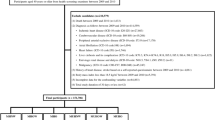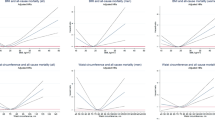Abstract
Background:
It is still unclear whether weight gain from early to late adulthood affects longevity. Furthermore, no study has addressed its association with all-cause and cause-specific mortality in an Asian population.
Methods:
We prospectively assessed the association between an increase in body mass index (BMI) category since age 20 years and risk of all-cause, cardiovascular disease (CVD) and cancer mortality. Self-reported information pertaining to BMI was collected from 38 080 Japanese men and women aged 40–79 years at study entry in 1994 after exclusion of participants with a BMI of <18.5 kg/m2 at age 20 years or at study entry. We defined six patterns of increase in BMI category at age 20 years and study entry: stable normal, overweight and obese, normal to overweight or obese, and overweight to obese.
Results:
During 7 years of follow-up, 2617 participants died. After adjustment for potential confounders, we observed a significantly increased risk of all-cause mortality for the pattern of normal weight at age 20 years and obese at study entry and of stable obese compared with stable normal in BMI category, the multivariate HRs (95% confidence interval (CI)) being 1.42 (1.08–1.88) and 2.26 (1.45–3.51), respectively. For the pattern of overweight at age 20 years and obese at study entry, the multivariate hazard ratio (95% CI) was 1.35 (0.92–1.98). In contrast, we did not observe an increased risk of all-cause mortality for normal weight at age 20 years and overweight at study entry, and stable overweight. For CVD and cancer mortality, these results were consistently observed.
Conclusion:
We observed an increased risk of all-cause mortality both among participants who had been persistently obese since early adulthood and participants who showed an increase in BMI category from normal to obese, compared with participants with a stable normal BMI category.
This is a preview of subscription content, access via your institution
Access options
Subscribe to this journal
Receive 12 print issues and online access
$259.00 per year
only $21.58 per issue
Buy this article
- Purchase on Springer Link
- Instant access to full article PDF
Prices may be subject to local taxes which are calculated during checkout
Similar content being viewed by others
References
Gunnell DJ, Frankel SJ, Nanchahal K, Peters TJ, Davey Smith G . Childhood obesity and adult cardiovascular mortality: a 57-y follow-up study based on the Boyd Orr cohort. Am J Clin Nutr 1998; 67: 1111–1118.
Whittemore AS, Paffenbarger Jr RS, Anderson K, Lee JE . Early precursors of site-specific cancers in college men and women. J Natl Cancer Inst 1985; 74: 43–51.
Must A, Strauss RS . Risks and consequences of childhood and adolescent obesity. Int J Obes Relat Metab Disord 1999; 23: S2–S11.
World Health Organization. Obesity: Preventing and Managing the Global Epidemic: Report of a WHO Consultation WHO Technical Report Series 894 World Health Organization: Geneva, 2000.
World Cancer Research Fund/American Institute for Cancer Research. Food, Nutrition, Physical Activity, and the Prevention of Cancer: a Global Perspective. AICR: Washington DC, 2007.
Corrada MM, Kawas CH, Mozaffar F, Paganini-Hill A . Association of body mass index and weight change with all-cause mortality in the elderly. Am J Epidemiol 2006; 163: 938–949.
Hu FB, Willett WC, Li T, Stampfer MJ, Colditz GA, Manson JE . Adiposity as compared with physical activity in predicting mortality among women. N Engl J Med 2004; 351: 2694–2703.
Jeffreys M, McCarron P, Gunnell D, McEwen J, Smith GD . Body mass index in early and mid-adulthood, and subsequent mortality: a historical cohort study. Int J Obes Relat Metab Disord 2003; 27: 1391–1397.
Yarnell JW, Patterson CC, Thomas HF, Sweetnam PM . Comparison of weight in middle age, weight at 18 years, and weight change between, in predicting subsequent 14 year mortality and coronary events: Caerphilly Prospective Study. J Epidemiol Community Health 2000; 54: 344–348.
Rosengren A, Wedel H, Wilhelmsen L . Body weight and weight gain during adult life in men in relation to coronary heart disease and mortality. A prospective population study. Eur Heart J 1999; 20: 269–277.
Wilcosky T, Hyde J, Anderson JJ, Bangdiwala S, Duncan B . Obesity and mortality in the Lipid Research Clinics Program Follow-up Study. J Clin Epidemiol 1990; 43: 743–752.
Tsuji I, Nishino Y, Ohkubo T, Kuwahara A, Ogawa K, Watanabe Y et al. A prospective cohort study on National Health Insurance beneficiaries in Ohsaki, Miyagi Prefecture, Japan: study design, profiles of the subjects and medical cost during the first year. J Epidemiol 1998; 8: 258–263.
Tsuji I, Kuwahara A, Nishino Y, Ohkubo T, Sasaki A, Hisamichi S . Medical cost for disability: a longitudinal observation of national health insurance beneficiaries in Japan. J Am Geriatr Soc 1999; 47: 470–476.
Kuriyama S, Shimazu T, Ohmori K, Kikuchi N, Nakaya N, Nishino Y et al. Green tea consumption and mortality due to cardiovascular disease, cancer, and all causes in Japan: the Ohsaki study. JAMA 2006; 296: 1255–1265.
Ogawa K, Tsubono Y, Nishino Y, Watanabe Y, Ohkubo T, Watanabe T et al. Validation of a food-frequency questionnaire for cohort studies in rural Japan. Public Health Nutr 2003; 6: 147–157.
World Health Organization. Physical status: the use interpretation of anthropometry Report of a WHO Expert Committee. WHO Tech Rep Ser 1995; 5: 153–157.
Kuriyama S, Tsuji I, Ohkubo T, Anzai Y, Takahashi K, Watanabe Y et al. Medical care expenditure associated with body mass index in Japan: the Ohsaki Study. Int J Obes Relat Metab Disord 2002; 26: 1069–1074.
World Health Organization. International Statistical Classification of Diseases and Related Health Problems. 10th Revision. World Health Organization: Geneva, 1992.
SAS Institute. SAS/STAT 9.1 User's Guide. SAS Institute: Cary, NC, 2004.
Tsubono Y, Tsuji I, Fujita K, Nakaya N, Hozawa A, Ohkubo T et al. Validation of walking questionnaire for population-based prospective studies in Japan: comparison with pedometer. J Epidemiol 2002; 12: 305–309.
Tamakoshi K, Yatsuya H, Kondo T, Hirano T, Hori Y, Yoshida T et al. The accuracy of long-term recall of past body weight in Japanese adult men. Int J Obes Relat Metab Disord 2003; 27: 247–252.
Acknowledgements
This study was supported by a Health Sciences Research Grant for Health Services (H18-Choju-Ippan-014, H16-Seisaku-Ippan-023, H18-Junkankitou (Seisyu)-Ippan-012) from the Ministry of Health, Labour and Welfare, Japan. We are grateful to all the participants of this study. None of the authors had any conflict of interest.
Author information
Authors and Affiliations
Corresponding author
Rights and permissions
About this article
Cite this article
Shimazu, T., Kuriyama, S., Ohmori-Matsuda, K. et al. Increase in body mass index category since age 20 years and all-cause mortality: a prospective cohort study (the Ohsaki Study). Int J Obes 33, 490–496 (2009). https://doi.org/10.1038/ijo.2009.29
Received:
Revised:
Accepted:
Published:
Issue Date:
DOI: https://doi.org/10.1038/ijo.2009.29
Keywords
This article is cited by
-
Self-Reported Early and Later Life Weight and the Risk of All-Cause Mortality in Older Adults
The Journal of nutrition, health and aging (2023)
-
Long-term changes in body weight and physical activity in relation to all-cause and cardiovascular mortality: the HUNT study
International Journal of Behavioral Nutrition and Physical Activity (2019)
-
Impact of body mass index and body weight variabilities on mortality: a nationwide cohort study
International Journal of Obesity (2019)
-
The association between BMI and mortality using early adulthood BMI as an instrumental variable for midlife BMI
Scientific Reports (2018)
-
Long-term weight changes in obese young adult men and subsequent all-cause mortality
International Journal of Obesity (2013)



